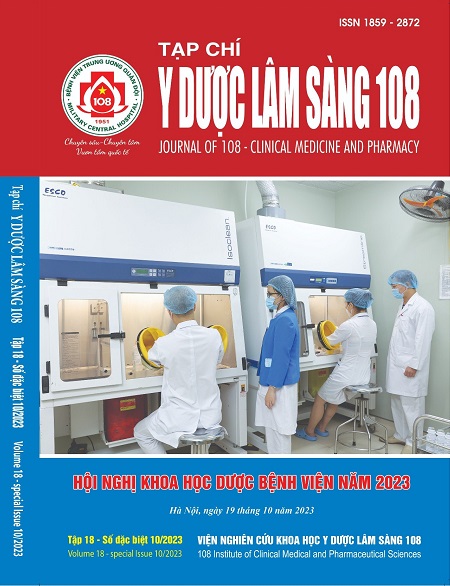Thực trạng sử dụng thuốc trên bệnh nhân suy giảm chức năng thận tại Bệnh viện Quân đội Trung ương 108
Main Article Content
Keywords
Tóm tắt
Mục tiêu: Xây dựng danh mục thuốc chống chỉ định trên bệnh nhân suy giảm chức năng thận dựa trên đồng thuận tài liệu và phân tích thực trạng sử dụng tại Bệnh viện Trung ương Quân đội (TWQĐ) 108. Đối tượng và phương pháp: Danh mục thuốc theo mức lọc cầu thận (MLCT) khuyến cáo chống chỉ định theo MLCT được xây dựng dựa trên sự đồng thuận giữa các cơ quan quản lý trên thế giới. Thực trạng sử dụng thuốc được xác định bằng nghiên cứu hồi cứu lượt kê đơn thuốc trên bệnh án điện tử của bệnh nhân tại Bệnh viện TWQĐ 108 trong khoảng thời gian 6 tháng cuối năm 2022. Các dữ liệu được thu thập bao gồm: Tuổi bệnh nhân, giới tính, cân nặng, bệnh mắc kèm, tiền sử dùng thuốc và kết quả xét nghiệm creatinin. Kết quả: Từ hơn 2500 thuốc thuộc danh mục của bệnh viện, 14 hoạt chất đủ điều kiện đưa vào danh mục nghiên cứu. Trong số 143261 lượt kê đơn từ tháng 7/2022 tới tháng 12/2022, 485 lượt thuốc có khuyến cáo ở mức độ chống chỉ định được phát hiện (chiếm 0,34%). Ngoài ra, với 95396 bệnh nhân được kê đơn ít nhất một loại thuốc trong danh mục vừa xây dựng, 0,16% (n = 151) bệnh nhân có sử dụng ít nhất một loại thuốc có khuyến cáo mức độ chống chỉ định. Franilaxâ (Spironolacton & Furosemid) là thuốc gặp phải phổ biến nhất, chiếm 64,3% tổng số bệnh nhân. Kết luận: Nghiên cứu cung cấp bằng chứng cho thấy sự cần thiết để bệnh viện xây dựng quy trình quản lý sử dụng thuốc trên bệnh nhân suy thận nặng. Việc ứng dụng CDSS vào phần mềm kê đơn có thể là một giải pháp cho thực trạng này.
Article Details
Các tài liệu tham khảo
2. Lipska KJ et al (2016) Citizen petition to the US food and drug administration to change prescribing guidelines: The metformin experience. Circulation, 134(18): 1405-1408.
3. Michaels AD et al (2010) Medication errors in acute cardiovascular and stroke patients: A scientific statement from the American Heart Association. Circulation 121(14): 1664-82.
4. Roux-Marson C et al (2020) Medication burden and inappropriate prescription risk among elderly with advanced chronic kidney disease. BMC Geriatrics 20(1): 87.
5. Ltd, GPE (2019) Summary of Product Characteristics Acarbose 100mg Tablets 2019; Available from: https://www.medicines.org.uk/emc/product/10000/smpc/print.
6. Laroche ML, Charmes JP, and Merle L (2007) Potentially inappropriate medications in the elderly: A French consensus panel list. Eur J Clin Pharmacol, 63(8): 725-731.
7. Helmer-Hirschberg O (1967) Analysis of the future: The delphi method. Santa Monica, CA: RAND Corporation.
8. American Geriatrics Society 2023 Updated AGS Beers Criteria® for potentially inappropriate medication use in older adults. J Am Geriatr Soc.
9. Administration, T.U.S.F.a.D. (2016) FDA revises warnings regarding use of the diabetes medicine metformin in certain patients with reduced kidney function.
10. Agency, t.E.M. (2016) Use of metformin to treat diabetes now expanded to patients with moderately reduced kidney function.
11. Vasisht KP et al (2010) Limitations of metformin use in patients with kidney disease: Are they warranted? Diabetes Obes Metab 12(12): 1079-1083.
12. Roussel R et al (2010) Metformin use and mortality among patients with diabetes and atherothrombosis. Arch Intern Med 170(21): 1892-1899.
13. Warren RE et al (2007) Introducing estimated glomerular filtration rate (eGFR) into clinical practice in the UK: implications for the use of metformin. Diabet Med 24(5): 494-497.
14. Ekström N et al (2012) Effectiveness and safety of metformin in 51 675 patients with type 2 diabetes and different levels of renal function: A cohort study from the Swedish National Diabetes Register. BMJ Open 2(4).
15. Eppenga WL et al (2014) Risk of lactic acidosis or elevated lactate concentrations in metformin users with renal impairment: A population-based cohort study. Diabetes Care 37(8): 2218-2224.
16. Compendium, e.m. Cozaar - Comp 100/12.5mg Film-Coated Tablets Summary of Product Characteristics. 2022; Available from: https://www.medicines.org.uk/emc/product/7783/smpc/print.
17. DailyMed T (2020) Losartan potassium and hydrochlorothiazide - losartan potassium and hydrochlorothiazide tablet, film coated. 2020; Available from: https://dailymed.nlm.nih. gov/dailymed/drugInfo.cfm?setid=e0b74a86-3d36-1af0-e538-41b45b8d2cc3.
18. Doody HK et al (2015) Retrospective evaluation of potentially inappropriate prescribing in hospitalized patients with renal impairment. Current Medical Research and Opinion 31(3): 525-535.
19. Guirguis-Blake J et al (2018) Prescription of high-risk medications among patients with chronic kidney disease: A cross-sectional study from the Washington, Wyoming, Alaska, Montana and Idaho region Practice and Research Network. Fam Pract 35(5): 589-594.
20. Youssef A et al (2015) Contraindicated medications administered to inpatients with renal insufficiency in a Saudi Arabian hospital that has a computerized clinical decision support system. Journal of Taibah University Medical Sciences 10(3): 320-326.
21. Jardine MJ et al (2010) Aspirin is beneficial in hypertensive patients with chronic kidney disease: a post-hoc subgroup analysis of a randomized controlled trial. Journal of the American College of Cardiology 56(12): 956-965.
 ISSN: 1859 - 2872
ISSN: 1859 - 2872
